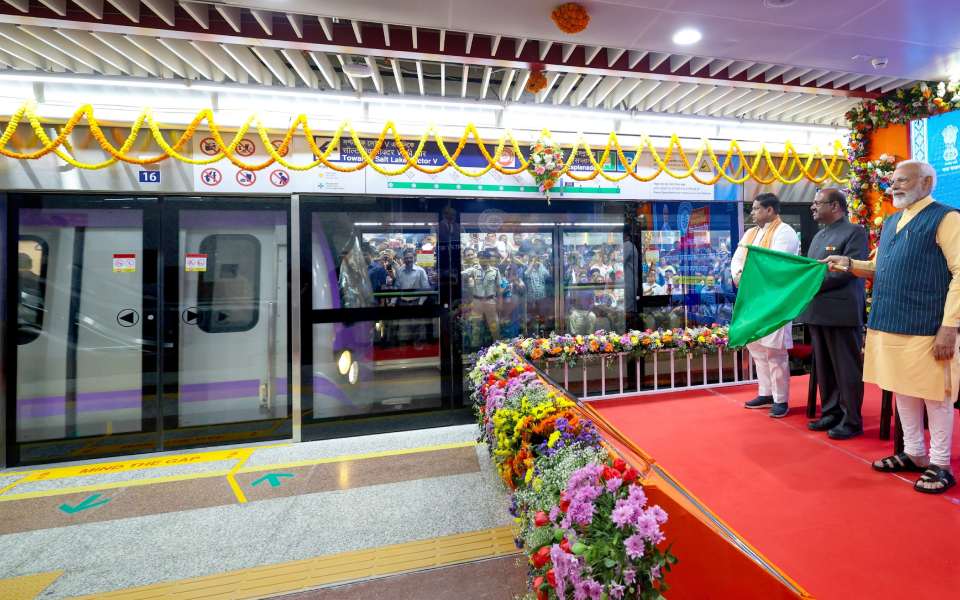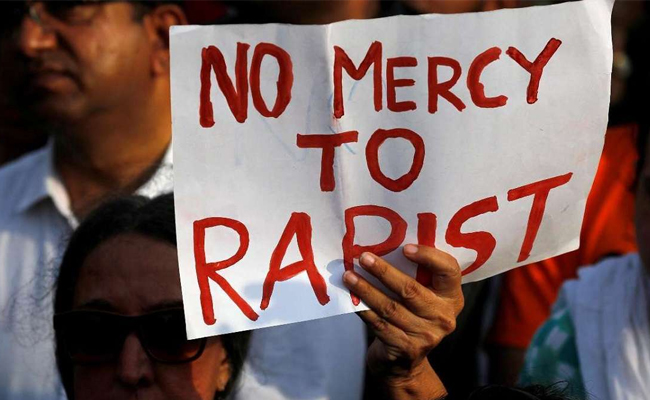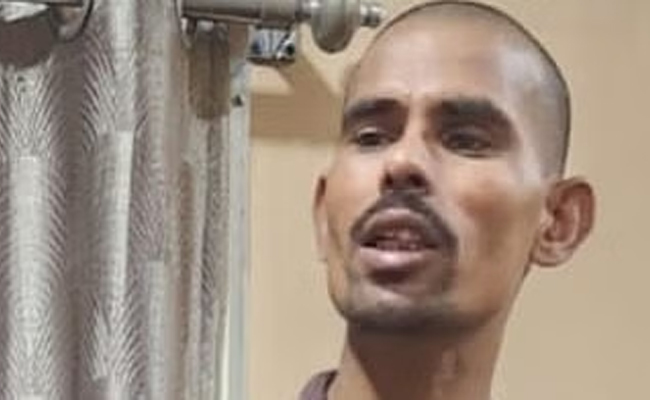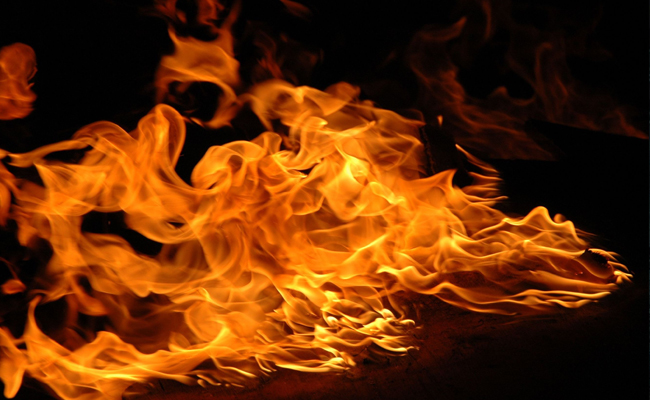Kolkata, Mar 6 (PTI) Prime Minister Narendra Modi on Wednesday inaugurated Kolkata Metro's Esplanade-Howrah Maidan section, which passes below the mighty Hooghly river through the country's first underwater transportation tunnel.
He also took a ride on a metro train from Esplanade to Howrah Maidan and interacted with school students during the journey passing through the tunnel, which is a testament to the country's engineering capabilities.
He returned to the Esplanade station through the same route, and was accompanied by Leader of the Opposition in the state Suvendu Adhikari during the trip.
Chief Minister Mamata Banerjee did not attend the programme.
The 4.8-km Esplanade-Howrah Maidan stretch, which is a part of the East-West Corridor, has been built at a cost of Rs 4,960 crore, officials said.
The PM also inaugurated the 1.25-km-long Taratala-Majherhat section of the Joka-Esplanade line. It has been built at a cost of Rs 520 crore, they said.
The Rs 1,430-crore Kavi Subhash-Hemanta Mukhopadhyay section of the New Garia-Airport line was also inaugurated from the function at the Esplanade metro station.
The Kavi Subhash-Hemanta Mukhopadhyay stretch, which is 5.4 km long, will bring the areas in the south-eastern parts of Kolkata on the metro map, officials said.
These sections will help decongest road traffic and provide seamless, easy and comfortable connectivity, a statement said.
The Howrah Maidan-Esplanade section of the East-West corridor has the first transportation tunnel under "any mighty river in India". It passes under the Hooghly river, on the east and west banks of which Kolkata and Howrah are situated.
The stretch also has the deepest metro station in the country -- the Howrah metro station, at 32 metre below the ground.
The East-West metro corridor, the construction for which commenced on April 14, 2009, has suffered several delays owing to various issues, including accidents at Bowbazar in central Kolkata.
The stretch between Howrah Maidan and Esplanade is the second section of the corridor, in which commercial operations would begin. With this, only the Esplanade-Sealdah stretch of the line is left to be completed.
Metro Railway general manager P Uday Kumar Reddy had earlier said it is targeting June-July this year to start commercial operation on the entire line.
Completion of the project has suffered delays owing to an aquifer burst at Bowbazar on August 31, 2019, leading to severe ground subsidence and the collapse of a number of buildings there and two more water leakage incidents at the same site in 2022 during tunneling and construction work.
The Salt Lake Sector V to Sealdah stretch of the East-West Metro corridor is commercially operational at present.
Of the total 16.6 km length of the line, the underground section is 10.8 km long between Howrah Maidan and Phoolbagan, while the rest is elevated.
The Majerhat metro station of the Taratala-Majerhat section is a unique elevated metro station across railway lines, platforms and a canal, the statement said.
The 6.5-km section between Joka and Taratala of the Joka-Esplanade line is already operational.
Along with these, the PM unveiled metro projects in various cities of the country. These projects are cumulatively worth around Rs 15,400 crore, officials said.
#WATCH | West Bengal: Prime Minister Narendra Modi interacts with school students as they travel in India's first underwater metro train, in Kolkata. pic.twitter.com/lQye0OnuqP
— ANI (@ANI) March 6, 2024
#WATCH | India's first underwater metro rail service in Kolkata set to be inaugurated by PM Modi on 6th March pic.twitter.com/ib5938Vn8x
— ANI (@ANI) March 5, 2024
#WATCH | West Bengal: Visuals of India's first underwater metro train to be inaugurated by Prime Minister Narendra Modi in Kolkata today. pic.twitter.com/VxJ0LNlVk1
— ANI (@ANI) March 6, 2024
Let the Truth be known. If you read VB and like VB, please be a VB Supporter and Help us deliver the Truth to one and all.
New Delhi: Regional cinema outshone Bollywood and Hollywood in 2024, marking a transformative year for the Indian film industry. According to the Ormax Media Box Office Report, Indian cinema’s gross collections stood at ₹11,833 crore, reflecting a 3% decline from the record ₹12,000 crore in 2023.
Hindi cinema faced a 13% drop in gross collections, falling from ₹5,380 crore in 2023 to ₹4,679 crore in 2024. Contributing just 40% to the total box office, down from 44% last year, Bollywood struggled to maintain its dominance. Dubbing of South Indian films accounted for 31% of Hindi cinema’s collections, with Pushpa 2: The Rule becoming the highest-grossing dubbed Hindi film at ₹889 crore. Excluding dubbed films, original Hindi releases saw a steep 37% decline.
Hollywood also faced challenges, with collections dropping 17% to ₹941 crore from ₹1,139 crore in 2023. The year’s top Hollywood film, Mufasa: The Lion King, earned ₹172 crore, ranking 11th in the overall box office.
The Telugu action thriller Pushpa 2: The Rule dominated globally, grossing ₹1,403 crore and becoming the highest-grossing film of the year. Its Hindi-dubbed version set a record as the highest-grossing Hindi-language film ever. Other major hits included Kalki 2898 AD (₹747 crore), Stree 2 (₹674 crore), and Tamil thriller The Greatest Of All Time. Films like Devara – Part 1 and Bhool Bhulaiyaa 3 also crossed ₹300 crore each.
Regional industries recorded remarkable growth. Malayalam cinema doubled its market share to 10%, crossing ₹1,000 crore for the first time, led by the survival thriller Manjummel Boys (₹164 crore). Tamil and Telugu cinema maintained their strong positions with 15% and 20% market shares, respectively. Gujarati cinema saw a notable 66% growth, collecting ₹84 crore.
Despite robust earnings driven by higher ticket prices, theatre attendance fell to 88.3 crore, a 6% drop from 2023 and 14% below pre-pandemic levels in 2019. The average ticket price rose to ₹134, a 26% increase from ₹106 in 2019.





